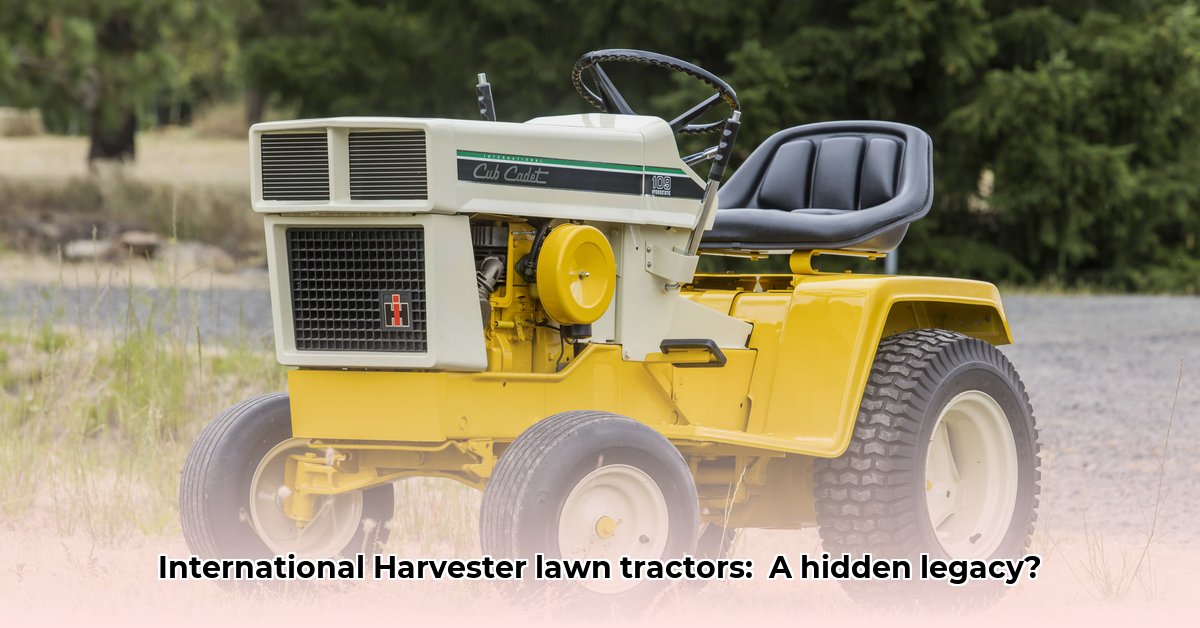
International Harvester Lawn Tractor: A Legacy Forged in the Fields
From Farm Giants to Backyard Powerhouses: International Harvester (IH), renowned for its robust farm equipment, surprisingly entered the lawn tractor market in the early 1960s with the Cub Cadet. This wasn't a random move; it was a strategic decision leveraging existing manufacturing expertise to tap into a burgeoning suburban market. This transition from massive farm tractors to smaller, homeowner-focused machines speaks volumes about IH's adaptability and market acumen. But what precisely propelled the Cub Cadet to household-name status?
For more information on IH tractors, see this helpful resource.
A Design Rooted in Agricultural Expertise: The early Cub Cadets weren't mere scaled-down versions of their larger counterparts. They incorporated decades of IH's agricultural engineering experience, resulting in robust construction, surprisingly powerful engines (for their size), and a reputation for solid reliability. This legacy is evident in their enduring appeal. However, precise early production figures remain elusive, highlighting the challenges inherent in researching older equipment history.
Adapting to the Changing American Landscape: The 1960s and 70s witnessed a dramatic expansion of American suburbs. Smaller properties demanded smaller, more maneuverable equipment—a need perfectly filled by the Cub Cadet. It served both small-scale farmers and homeowners, proving its versatility and adaptability. Many used them for light farm tasks, solidifying their appeal as a multi-purpose tool. This adaptability proved crucial to their success. Did this versatility contribute to their enduring popularity? The evidence strongly suggests yes.
The Shifting Sands of the Industry: A Business Story: Economic shifts and industry consolidation eventually impacted IH. In 1981, IH sold its Lawn Products Group, including the Cub Cadet line, to MTD Products. This business decision underscores the intense competition and financial pressures within the agricultural equipment industry at the time. This sale significantly impacted parts and service availability, a factor affecting the long-term fate of the Cub Cadet.
A Legacy that Continues to Grow: Vintage International Harvester Cub Cadets are highly prized by collectors for their robust build and historical significance. They represent a unique era, bridging the gap between large-scale farm machinery and the more modest needs of suburban homeowners. The Cub Cadet's enduring popularity raises this question: What lasting impact did these tractors have on farming communities? Further research is needed to fully answer this important question. Could we see modern adaptations building on their reliable designs to offer sustainable solutions for today's homeowners and small-scale farmers? The possibility is intriguing.
How to Find Replacement Parts for Vintage International Harvester Cub Cadet Tractors
Key Takeaways:
- The market for vintage International Harvester Cub Cadet tractor parts is niche but active.
- Specialized suppliers cater to this demand.
- Finding parts requires research and a proactive approach.
- Online communities and forums are invaluable resources.
- Preventative maintenance extends the life of these machines.
The Cub Cadet's Rise and Fall (and Continued Resurgence)
The International Harvester Cub Cadet story reflects the American agricultural landscape. Designed for smaller farms and home use, these machines became iconic for their sturdy build and affordability. However, facing economic challenges, IH sold the Cub Cadet line. This didn't mean the end, though. Their classic design and dependable engines continue to attract collectors, hobbyists, and small-scale farmers. This leads to an important question: where can you find those essential replacement parts?
Navigating the Parts Maze: Where to Look
Finding parts can be challenging but rewarding. Start with online retailers specializing in antique tractor parts; many offer detailed catalogs and diagrams. Don't overlook online forums and Cub Cadet communities; these offer invaluable advice and parts leads from fellow enthusiasts. Think of it as a virtual parts-finding network. These communities offer technical support and camaraderie. They’re key in troubleshooting issues and learning from those who've faced similar challenges.
Beyond the Digital Landscape: Local and Regional Resources
Consider local antique machinery dealers and restoration shops; they may have parts or know someone who does. Attend antique tractor shows and swap meets—excellent places to find rare parts and network. In-person networking complements online searches.
The Importance of Preventative Maintenance
Preventative maintenance is key to extending the lifespan of your tractor. Regular servicing and lubrication prevent small issues from becoming major repairs. Consider it an investment protecting your investment.
A Final Word on Sourcing Parts
Finding parts takes time and effort, but the process—including the searches, discoveries, and connections with fellow enthusiasts—is part of the reward. Patience and persistence are crucial in preserving a piece of agricultural history. Restoring these tractors becomes a compelling narrative in itself.